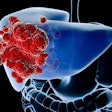An approach to tracking breast tumors shrunken in chemotherapy, and a comparison of modalities for evaluating peripheral arteries in diabetics, are among the highlights in this month's American Journal of Roentgenology.
The increasing use of neoadjuvant chemotherapy before surgery in breast cancer has enabled breast-conserving therapy for many patients. But sometimes chemotherapy is so successful that it presents a problem, according to radiologists at the University of North Carolina, Chapel Hill.
"(A) problem we have encountered is that in some patients, response to chemotherapy is so good that no remaining physical or imaging evidence of the primary tumor remains," the authors write.
Using anatomic landmarks may be imprecise, they note, yet precision is important for targeting any residual carcinoma in breast-conserving surgery. So at UNC, breast cancer patients who are likely to undergo breast conservation are having their tumors marked with embolization coils before chemotherapy.
Platinum coils that don't interfere with MR imaging, developed by Cook of Bloomington, IN, are deployed under sonographic guidance using an 18-gauge 7-cm long vascular entry needle, the researchers write, "using a freehand technique similar to that used for a cyst aspiration."
While a similar deployment of metallic markers using a 15-gauge needle was described in AJR in 1997, the authors suggest their approach may be accomplished more easily with an 18-gauge needle.
The procedure has been well tolerated by the eight patients who have undergone it to date, and none of the coils have migrated after placement. The coils cannot be well visualized on sonograms, so mammography is used for localization, the authors note.
"With neoadjuvant chemotherapy, the exact effect on tumor shrinkage is unpredictable," the researchers write. "In addition to ensuring removal of the original tumor bed, the approach we describe will allow correlation of the mammographic appearance with the histologic appearance and may provide useful information in determining how large solid tumors are destroyed by chemotherapy."
3-D MRA in diabetics
Foot complications are common in diabetics, potentially leading to amputation and warranting precise imaging of peripheral vessels to facilitate potential surgical revascularization. With that in mind, researchers from Johannes Gutenberg-University Mainz in Germany compared the performance of 3-D MRA and digital subtraction angiography in evaluating these vessels.
Intraareterial DSA has been the standard for preoperative diagnostic imaging in the evaluation of peripheral and particularly intrapopliteal arteries, note the authors. However, "some studies have shown that DSA in combination with standard angiography may fail to reveal patent arteries that are suitable for distal bypass grafting in patients with severe arterial occlusive disease."
In addition, while studies have recommended two-dimensional time-of-flight MR angiography as an adjunct imaging study, the technique has limitations, the authors write. "Most of these problems have been resolved by the introduction of contrast-enhanced three-dimensional MR angiography using gadolinium chelates as the contrast agent."
The researchers used both DSA and contrast-enhanced 3-D MRA to image 24 consecutive patients with diabetes mellitus and grade III chronic limb ischemia involving either nonhealing ulceration or focal gangrene with diffuse pedal ischemia.
"The results of our study indicate that in diabetic patients with severe peripheral arterial occlusive disease, contrast-enhanced MR angiography is superior to DSA for the identification of patent arterial segments in the runoff vessels of the foot -- even when compared with a selective DSA technique," the authors report.
Specifically, MRA showed the pedal arch vessels in 92% of the patients, while they were visible in only 38% of DSA images.
While acknowledging the limitations of their study -- including selection bias, lack of a uniform DSA technique, and restrictions on contrast with DSA -- the authors report that their findings have now changed the diagnostic algorithm at their institution.
By Tracie L. ThompsonAuntMinnie.com staff writer
January 18, 2000
Copyright © 2000 AuntMinnie.com



















